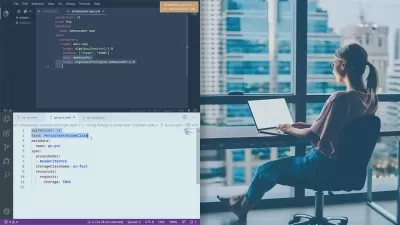System Design for Interviews and Beyond
Focused View
7:51:50
126 View
01 Introduction - Course Introduction.mp4
03:58
02 Introduction - Who will benefit from the course and how.mp4
03:04
03 Introduction - Course overview.mp4
04:50
04 How to define System requirements - System requirements.mp4
06:03
05 How to define System requirements - Functional requirements.mp4
04:38
06 How to define System requirements - High availability.mp4
10:00
07 How to define System requirements - Fault tolerance, resilience, reliability.mp4
08:23
08 How to define System requirements - Scalability.mp4
06:16
09 How to define System requirements - Performance.mp4
09:29
10 How to define System requirements - Durability.mp4
09:12
11 How to define System requirements - Consistency.mp4
10:36
12 How to define System requirements - Maintainability, security, cost.mp4
09:35
13 How to define System requirements - Summary of system requirements.mp4
02:10
14 How to achieve certain system qualities with the help of hardare - Regions, availability zones, data centers, servers.mp4
08:52
15 How to achieve certain system qualities with the help of hardare - Physical servers, virtual machines, containers, serverless.mp4
07:46
16 Fundamentals of reliable, scalable, and fast communication - Synchronous vs asynchronous communication.mp4
03:29
17 Fundamentals of reliable, scalable, and fast communication - Asynchronous messaging patterns.mp4
06:27
18 Fundamentals of reliable, scalable, and fast communication - Network protocols.mp4
07:32
19 Fundamentals of reliable, scalable, and fast communication - Blocking vs non-blocking IO.mp4
10:40
20 Fundamentals of reliable, scalable, and fast communication - Data encoding formats.mp4
06:44
21 Fundamentals of reliable, scalable, and fast communication - Message acknoledgement.mp4
03:00
22 How to improve system performance with caching - Deduplication cache.mp4
07:45
23 How to improve system performance with caching - Metadata cache.mp4
06:00
24 The importance of queues in distributed systems - Queue.mp4
03:30
25 The importance of queues in distributed systems - Full and empty queue problems.mp4
09:55
26 The importance of queues in distributed systems - Start with something simple.mp4
01:38
27 The importance of queues in distributed systems - Blocking queue and producer-consumer pattern.mp4
04:04
28 The importance of queues in distributed systems - Thread pool.mp4
05:33
29 The importance of queues in distributed systems - Big compute architecture.mp4
03:47
30 Data store internals - Log.mp4
04:59
31 Data store internals - Index.mp4
04:01
32 Data store internals - Time series data.mp4
03:09
33 Data store internals - Simple key-value database.mp4
05:26
34 Data store internals - B-tree index.mp4
05:54
35 Data store internals - Embedded database.mp4
04:04
36 Data store internals - RocksDB.mp4
06:18
37 Data store internals - LSM-tree and B-tree.mp4
04:36
38 Data store internals - Page cache.mp4
07:15
39 How to build efficient communication in distributed systems - Push vs pull.mp4
04:05
40 How to build efficient communication in distributed systems - Host discovery.mp4
08:46
41 How to build efficient communication in distributed systems - Service discovery.mp4
06:31
42 How to build efficient communication in distributed systems - Peer discovery.mp4
09:04
43 How to build efficient communication in distributed systems - How to choose a network protocol.mp4
07:41
44 How to build efficient communication in distributed systems - Network protocols in real-life systems.mp4
09:52
45 How to build efficient communication in distributed systems - Video over HTTP.mp4
07:19
46 How to build efficient communication in distributed systems - CDN.mp4
05:14
47 How to build efficient communication in distributed systems - Push and pull technologies.mp4
08:03
48 How to build efficient communication in distributed systems - Push and pull technologies in real-life systems.mp4
06:24
49 How to build efficient communication in distributed systems - Large-scale push architectures.mp4
08:53
50 How to deliver data reliably - What else to know to build reliable, scalable, and fast systems.mp4
04:57
51 How to deliver data reliably - Timeouts.mp4
03:34
52 How to deliver data reliably - What to do with failed requests.mp4
05:39
53 How to deliver data reliably - When to retry.mp4
06:20
54 How to deliver data reliably - How to retry.mp4
03:48
55 How to deliver data reliably - Message delivery guarantees.mp4
06:50
56 How to deliver data reliably - Consumer offsets.mp4
08:07
57 How to deliver data quickly - Batching.mp4
07:24
58 How to deliver data quickly - Compression.mp4
04:22
59 How to deliver data at large scale - How to scale message consumption .mp4
08:06
60 How to deliver data at large scale - Partitioning in real-life systems.mp4
05:02
61 How to deliver data at large scale - Partitioning strategies.mp4
06:02
62 How to deliver data at large scale - Request routing.mp4
06:27
63 How to deliver data at large scale - Rebalancing partitions.mp4
07:45
64 How to deliver data at large scale - Consistent hashing.mp4
09:57
65 How to protect servers from clients - System overload.mp4
02:13
66 How to protect servers from clients - Autoscaling.mp4
04:37
67 How to protect servers from clients - Autoscaling system design.mp4
05:09
68 How to protect servers from clients - Load shedding.mp4
09:10
69 How to protect servers from clients - Rate limiting.mp4
11:47
70 How to protect clients from servers - Synchronous and asynchronous clients.mp4
07:24
71 How to protect clients from servers - Circuit breaker.mp4
04:07
72 How to protect clients from servers - Fail-fast design principle.mp4
07:31
73 How to protect clients from servers - Bulkhead.mp4
04:56
74 How to protect clients from servers - Shuffle sharding.mp4
07:26
75 Epilogue - The end (but not quite.mp4
00:40
More details
User Reviews
Rating
average 0
Focused display

Udemy
View courses UdemyStudents take courses primarily to improve job-related skills.Some courses generate credit toward technical certification. Udemy has made a special effort to attract corporate trainers seeking to create coursework for employees of their company.
- language english
- Training sessions 75
- duration 7:51:50
- Release Date 2023/06/16
























